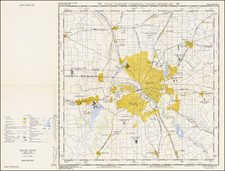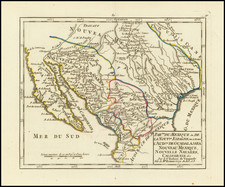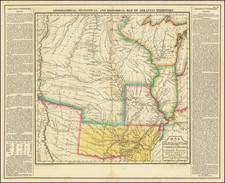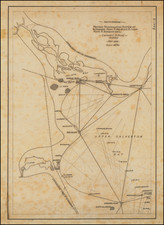First state of Burr's map of Texas, one of the two most important maps of Texas on the eve of its independence.
The map is of the utmost importance in the history of Texas, both as an early milestone in its development and as one of the earliest useful guide maps to the region. Of the 5 recorded states of the map (1833, 1834, 1835, 1845 and 1846), the 1833 is the rarest, with only a handful of copies known in American institutional collections. For example, the Libarry of Congress and most major Texas collections do not include this first state.
Of the 5 recorded states of the map, the 1833 is by far the rarest, with only a handful of copies known in American institutional collections. For example, the Libarry of Congress and most major Texas collections do not include this first state. This example of the map is signed twice on the verso by Abner Brush and A. Brush (likely the same person). Genealogical records suggest that this Abner Brush may have been a relative of Elkanah Brush. Elkanah Brush, was born in New York and moved to the Power and Hewetson colony at Refugio, Texas, in 1834, shortly after the completion of the Bray survey of Refugio in August 1834, and received a municipal land grant in Refugio on October 31, 1834. Two of Brush's sons also received grants.
On November 28, 1835, Brush was appointed by the General Council at San Felipe de Austin as a commissioner to organize the Refugio militia. He was a member of Ira J. Westover's party that joined George M. Collinsworth's command in the capture of Goliad in October 1835, and periodically between October 10, 1835, and January 16, 1836, he served under Capt. Philip Dimmitt in the Goliad garrison and on the Lipantitlán Expedition. On December 20, 1835, Brush was among 91 signers of the Goliad Declaration of Independence, which was the first such document to proclaim Texas' independence from Mexico. On July 1, 1836, he enlisted in Capt. Louis P. Cooke's company of Col. Edwin Morehouse's First Regiment, First Brigade, Army of the Republic of Texas. For his military service Brush received a bounty warrant for 1,280 acres, which he sold to Robert Peebles. Brush was elected to the House of Representatives of the First Congress of the Republic of Texas and fought a closely contested election for the Second. He was the apparent victor and was present at Houston at its first session, on September 25, 1837. But on October 2 William E. Walker of Victoria claimed the seat. Brush protested on the following day, and a recount showed that Walker had won by two votes. Walker was disqualified on October 7, however, as he was neither a citizen nor a resident. A special election was then called, and James Power was chosen to fill the vacant seat. Records also reflect that he owned One Labor of land in Travis County, Texas in 1840. He resided in Fort Bend County until at least 1850.
Genealogical records show that Brush had a daughter, Catherine, while still living in New York in 1832, strongly suggesting that Elkanah Brush traveled to Texas sometime in 1833 or 1834, possibly bearing this copy of Burr's map of Texas, furnished to him by Abner Brush. Given the timing of Elkanah's departure from New York and arrival in Texas, the prospect that only this first edition of Burr's map of Texas was available to Elkanah lends additional plausibility to this theory. Records reflect at least 2 Abner Brushes appear to have been in Suffolk County, New York during this time period, although we have not definitively made the connection to Elkanah.
G. W. & C. B. Colton was a prominent family firm of mapmakers who were leaders in the American map trade in the nineteenth century. Its founder, Joseph Hutchins Colton (1800-1893), was a Massachusetts native. Colton did not start in the map trade; rather, he worked in a general store from 1816 to 1829 and then as a night clerk at the United States Post Office in Hartford, Connecticut. By 1830, he was in New York City, where he set up his publishing business a year later.
The first printed item with his imprint is dated 1833, a reprint of S. Stiles & Company’s edition of David Burr’s map of the state of New York. He also printed John Disturnell’s map of New York City in 1833. Colton’s next cartographic venture was in 1835, when he acquired the rights to John Farmer’s seminal maps of Michigan and Wisconsin. Another early and important Colton work is his Topographical Map of the City and County of New York and the Adjacent Country (1836). In 1839, Colton began issuing the Western Tourist and Emigrant’s Guide, which was originally issued by J. Calvin Smith.
During this first decade, Colton did not have a resident map engraver; he relied upon copyrights purchased from other map makers, most often S. Stiles & Company, and later Stiles, Sherman & Smith. Smith was a charter member of the American Geographical and Statistical Society, as was John Disturnell. This connection would bear fruit for Colton during the early period in his career, helping him to acquire the rights to several important maps. By 1850, the Colton firm was one of the primary publishers of guidebooks and immigrant and railroad maps, known for the high-quality steel plate engravings with decorative borders and hand watercolors.
In 1846, Colton published Colton’s Map of the United States of America, British Possessions . . . his first venture into the wall map business. This work would be issued until 1884 and was the first of several successful wall maps issued by the firm, including collaborative works with D.G. Johnson. From the 1840s to 1855, the firm focused on the production of railroad maps. Later, it published a number of Civil War maps.
In 1855, Colton finally issued his first atlas, Colton’s Atlas of the World, issued in two volumes in 1855 and 1856. In 1857 the work was reduced to a single volume under the title of Colton’s General Atlas, which was published in largely the same format until 1888. It is in this work that George Woolworth (G. W.) Colton’s name appears for the first time.
Born in 1827 and lacking formal training as a mapmaker, G. W. joined his father’s business and would later help it to thrive. His brother Charles B. (C. B.) Colton would also join the firm. Beginning in 1859, the General Atlas gives credit to Johnson & Browning, a credit which disappears after 1860, when Johnson & Browning launched their own atlas venture, Johnson’s New Illustrated (Steel Plate) Family Atlas, which bears Colton’s name as the publisher in the 1860 and 1861 editions.
J.H. Colton also published a number of smaller atlases and school geographies, including his Atlas of America (1854-56), his Illustrated Cabinet Atlas (1859), Colton’s Condensed Cabinet Atlas of Descriptive Geography (1864) and Colton’s Quarto Atlas of the World (1865). From 1850 to the early 1890s, the firm also published several school atlases and pocket maps. The firm continued until the late 1890s, when it merged with a competitor and then ceased to trade under the name Colton.
David H. Burr studied law, passing the New York Bar Exam, and then surveying under Simeon DeWitt in New York. His first atlas was an atlas of New York State (1829), the second state atlas to be issued in the US (after Mills’ Atlas of South Carolina in 1826). In the 1830s, he served as the official topographer for the US Post Office, producing a series of rare and highly sought-after large-format state maps. He also created a map of the country’s postal routes, which features roads, canals, and railroads. Burr traveled to London to work with John Arrowsmith; together, they produced the American Atlas in 1839.
Upon his return to the States, Burr was appointed as a draftsman for the House of Representatives, where he worked until ca. 1841. He later worked for the Louisiana Survey and the Florida Survey. By 1850, he was back in Washington D. C., working on the census. In 1852, the Senate named Burr as the draftsman to compile maps from the Federal Surveys. In 1853, Burr traveled to San Francisco, perhaps as part of his work for the Senate. He was then named as the Surveyor General of Utah in 1855. However, he was unpopular there and returned to Washington D. C. by 1870. Burr is widely regarded as one of the most important names in the nineteenth-century American history of cartography.











![Nouvelle Carte Du Mexique, Du Texas Et D'Une Partie Des Etats Limitrophes . . . 1840 [Proposed Railroads In Texas -- First Appearance of Arizona on a Printed Map]](https://storage.googleapis.com/raremaps/img/small/103480.jpg)


![[Austins Colony] Mexico & Guatemala](https://storage.googleapis.com/raremaps/img/small/105610.jpg)